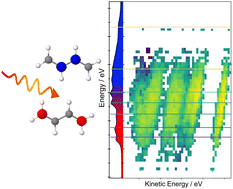Deconvolution of the X-ray absorption spectrum of trans-1,3-butadiene with resonant Auger spectroscopy†
Abstract
High-resolution carbon K-edge X-ray photoelectron, X-ray absorption, non-resonant and resonant Auger spectra are presented of gas phase trans-1,3-butadiene alongside a detailed theoretical analysis utilising nuclear ensemble approaches and vibronic models to simulate the spectroscopic observables. The resonant Auger spectra recorded across the first pre-edge band reveal a complex evolution of different electronic states which remain relatively well-localised on the edge or central carbon sites. The results demonstrate the sensitivity of the resonant Auger observables to the weighted contributions from multiple electronic states. The gradually evolving spectral features can be accurately and feasibly simulated within nuclear ensemble methods and interpreted with the population analysis.

- This article is part of the themed collections: Celebrating International Women’s day 2025: Women in physical chemistry and Molecular Dynamics in the Gas Phase


 Please wait while we load your content...
Please wait while we load your content...